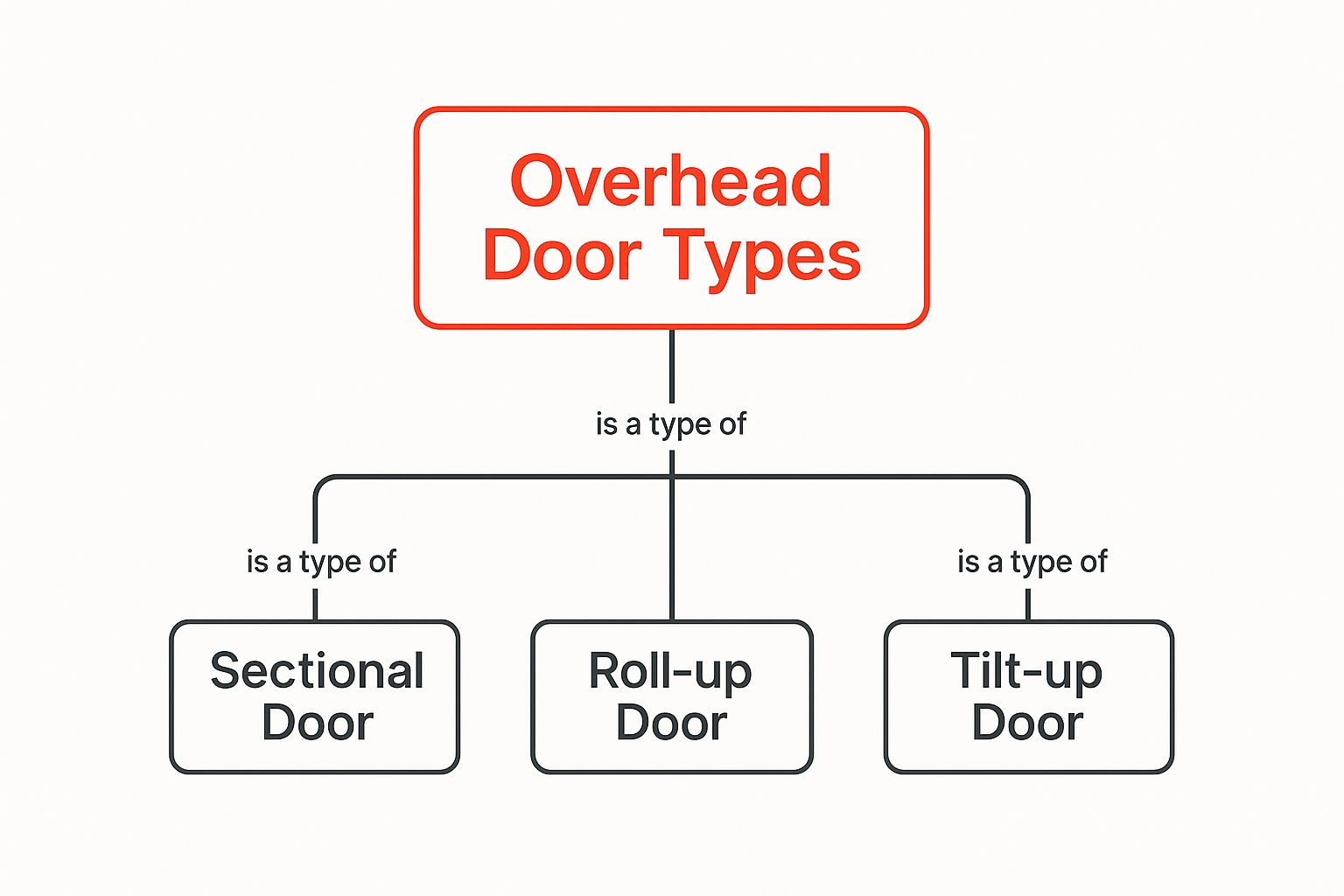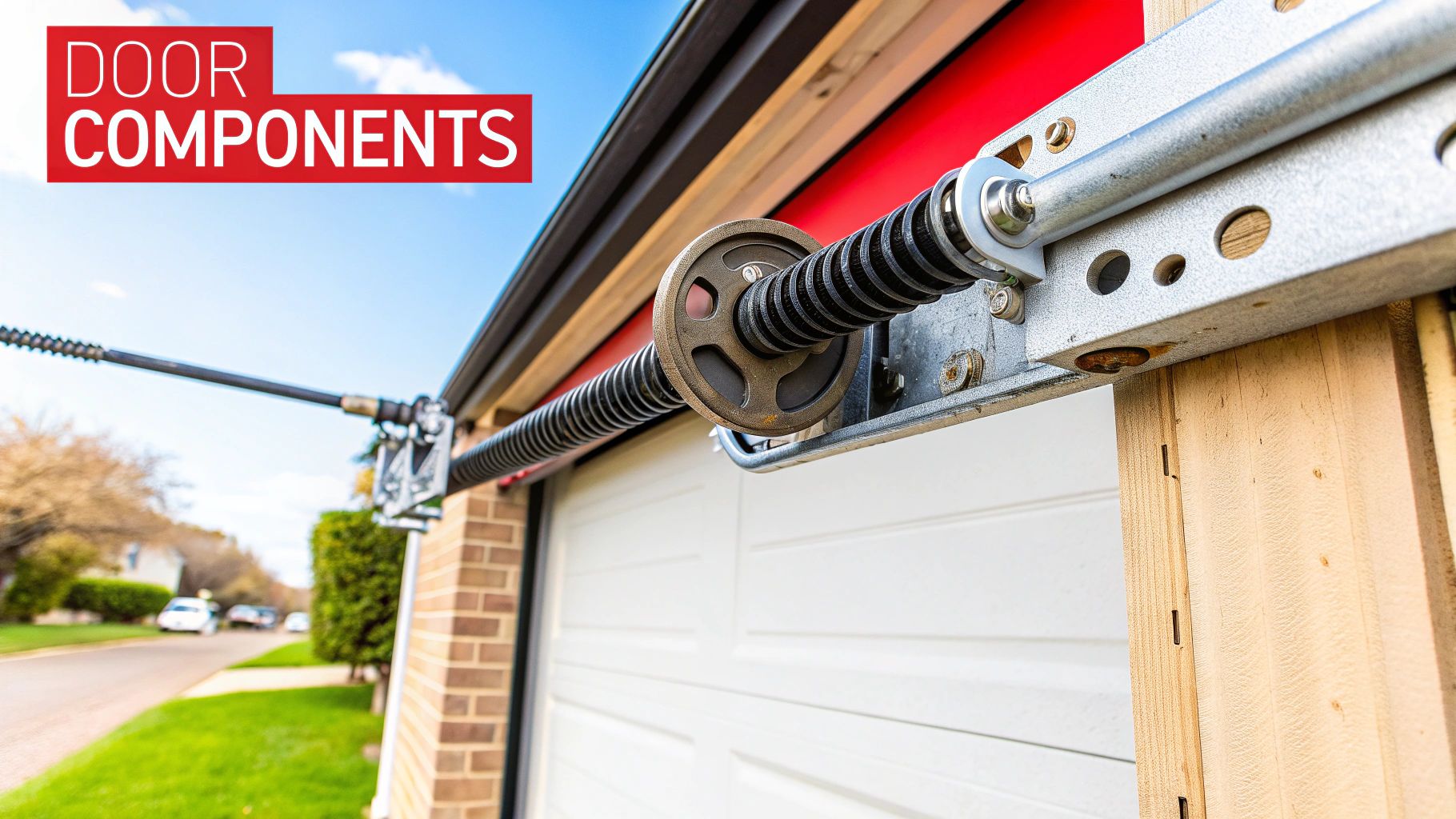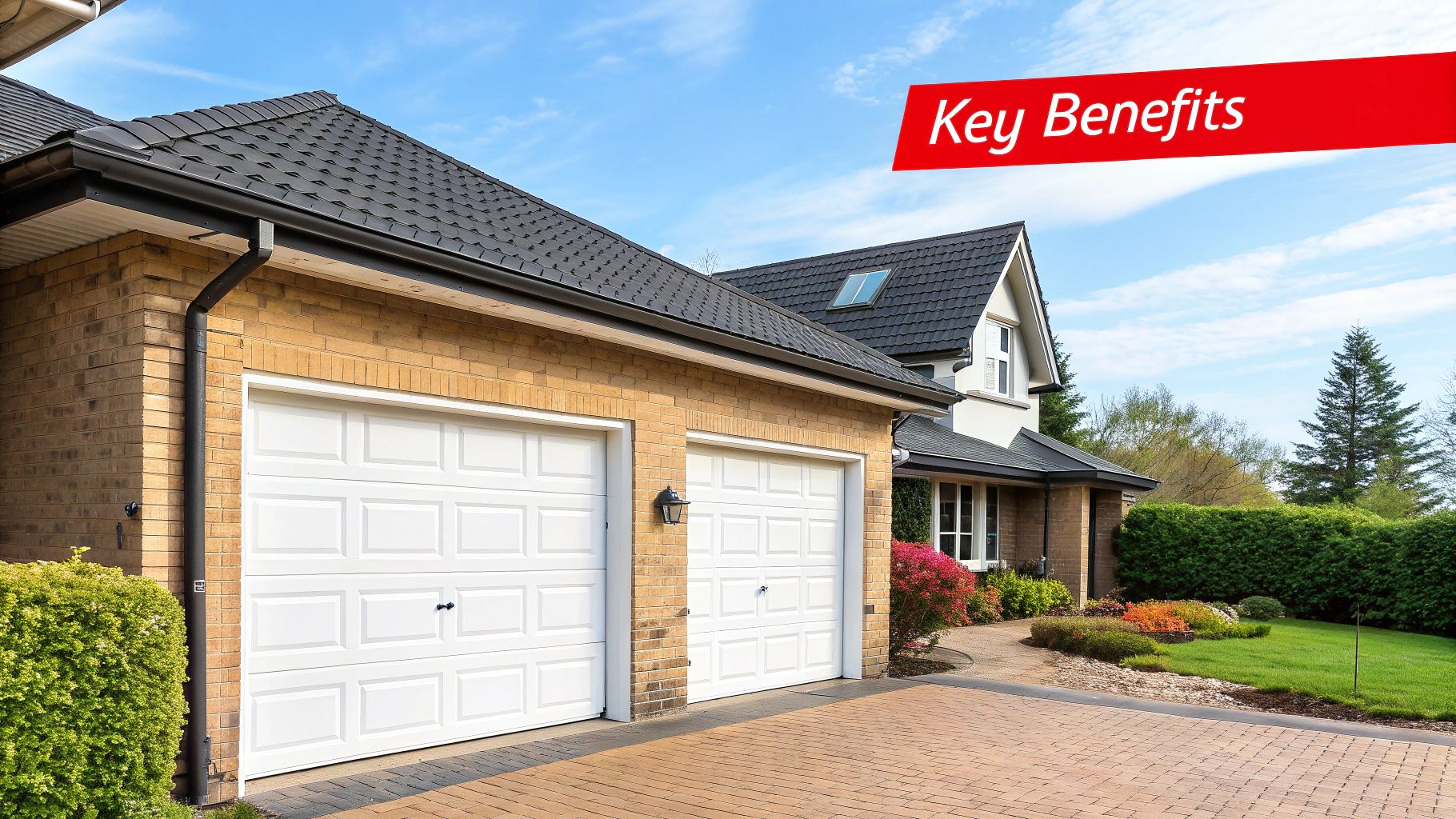You might hear the term "overhead door" and picture the simple garage door you grew up with. But in reality, it's a sophisticated system engineered to be the workhorse of your property. For homeowners and businesses across Texas and Oklahoma, it's a critical component of security, efficiency, and daily operations—a vertical drawbridge that provides essential access and protection.
What Exactly Is a Modern Overhead Door?
It’s easy to dismiss an overhead door as just a big slab of wood or metal. The truth is, it's a precisely calibrated assembly of panels, tracks, springs, rollers, and an operator. All these parts must work in perfect harmony to lift and lower a barrier weighing several hundred pounds, smoothly and safely, often thousands of times per year.
These systems have evolved significantly from the manually operated doors of the past. Today’s versions are integral to a property's infrastructure, often featuring smart technology, advanced automation, and high-performance insulation. They've shifted from being a purely functional necessity to a smart investment that impacts your property's value, security, and operational efficiency.
A Rapidly Expanding Market
The growing importance of these doors is clearly reflected in the market data. The global garage and overhead door industry was valued at a substantial $23.5 billion in 2023 and is projected to reach $35.8 billion by 2033. This isn't just a random spike; it shows a consistent and growing demand from property owners for access solutions that are reliable, secure, and energy-efficient.
This growth is fueled by tangible, real-world benefits.
An overhead door isn't an expense; it's an asset. It directly impacts your property's curb appeal, energy consumption, and daily security. For homeowners, the 2023 Cost vs. Value Report shows that a garage door replacement can recoup over 102% of its cost upon resale, making it one of the most practical upgrades you can make.
For businesses in Texas and Oklahoma, a high-performance commercial door is non-negotiable for keeping operations moving and protecting valuable assets. Whether you're considering a residential upgrade or need a robust solution for your commercial facility, professional Overhead Door Installation is critical—it guarantees every component functions as designed, right from the start.
To put it simply, here’s a quick breakdown of what you can expect from a modern overhead door in different settings.
Overhead Door at a Glance: Key Characteristics
| Characteristic | Residential Application | Commercial Application |
|---|---|---|
| Primary Function | Secure vehicle and home access, enhance curb appeal. | Facilitate logistics, secure inventory, and protect assets. |
| Material & Build | Often steel, aluminum, wood, or composite with insulation. | Heavy-duty steel, aluminum, or fiberglass for durability and high cycle counts. |
| Operation | Typically automated with remote or smart-home integration. | High-cycle operators, often with advanced safety and access controls. |
| Key Benefit | Boosts property value, improves energy efficiency, and provides convenience. | Increases operational efficiency, enhances security, and ensures safety. |
This table highlights that while the core concept is the same, the execution and priorities differ significantly between home and business use.
What Makes an Overhead Door Work? The Core Components
An overhead door is much more than the collection of panels you see from the curb. It's a finely tuned system where every single part plays a crucial role. Understanding the anatomy of your door system drives home why proper maintenance and professional service are essential for keeping it running safely and efficiently for years to come.
The torsion springs are the real muscle of the operation. They do the heavy lifting by counterbalancing the door's weight. This is how a door weighing hundreds of pounds can be lifted with one hand or a small motor. The springs, not the opener, provide the brawn.
The Parts That Get It Moving
A smooth, predictable ride up and down depends on core components working in perfect harmony. If one is out of alignment, the whole system can struggle.
- Tracks: These are the rigid framework, the skeleton that guides the rollers and makes sure the door follows a consistent path. Misaligned tracks cause jerky, binding motion and premature wear.
- Rollers: These are the joints. The small wheels sit inside the tracks, allowing door sections to glide with minimal friction. Loud, grinding noises often point to worn-out rollers.
- Cables and Drums: This duo works with the springs to hoist the door. As the door opens, the cables wind neatly around the drums, ensuring a perfectly balanced and even lift.
This graphic gives a great overview of the common overhead door designs you'll find.

As you can see, even though sectional, roll-up, and tilt-up doors look and operate differently, they all depend on a similar system of core components to get the job done.
Finally, you have the operator—the motor. This is the brain of the system. A common misconception is that the operator lifts the door's full weight. In reality, it just provides the initial push to overcome inertia; the springs handle the heavy lifting.
Actionable Tip: The entire system, especially the automated operator, must comply with UL 325 safety standards. These regulations mandate life-saving features like auto-reversing mechanisms and photo-eye sensors to prevent the door from closing on a person or object. Test your sensors monthly by placing an object (like a paper towel roll) in the door's path—if it doesn't reverse, call a professional immediately.
This intricate balance of parts is precisely why professional handling is a must. The springs and cables are under extreme tension and can be incredibly dangerous. To better understand these critical safety features, you can learn more about how overhead garage door sensors help protect your home and family.
Exploring Different Types of Overhead Doors

When you hear "overhead door," you might picture your home's garage door. But that's just one piece of a much larger puzzle. The term covers any door that opens upward by sliding or rolling along a track, and the variations are designed for vastly different jobs.
This versatility is why the global overhead door market was valued at an impressive $4.38 billion in 2021 and continues to expand. For homeowners and businesses across Texas and Oklahoma, knowing the key differences is crucial for making the right choice.
The most common type is the sectional door. Built from horizontal panels hinged together, it bends and follows a track up and along the ceiling. Sectional doors are the standard for residential garages because they offer a huge range of styles, materials, and insulation options.
But once you move into the commercial world, the demands—and the doors—change.
Commercial And Industrial Door Types
In a high-traffic warehouse or a secure industrial facility, you need something tougher than a standard residential door. This is where rolling steel doors, sometimes called coiling doors, come into play.
Instead of hinged panels, these doors are made of interlocking metal slats that coil up into a compact drum above the door opening. This design is incredibly durable, offers top-notch security, and saves overhead space.
Another workhorse of the commercial sector is the high-speed door. As the name suggests, these are all about efficiency, opening and closing in seconds. In places where temperature control is critical—like a cold storage facility or a clean-room environment—they are essential for preventing energy loss and keeping operations flowing smoothly, in compliance with standards like those from the Global Cold Chain Alliance (GCCA).
An overhead door’s performance is directly tied to its design. A sectional door offers curb appeal for a home, while a rolling steel door provides the brute strength a commercial facility demands. Choosing correctly from the start prevents future headaches and operational bottlenecks.
To help you visualize the differences, it helps to see them side-by-side.
Overhead Door Type Comparison
Here's a quick breakdown of the most common overhead door types to help you match the right design to your specific needs.
| Door Type | Best For | Key Benefit | Material Options |
| :— | :— | :— |
| Sectional Doors | Residential garages and some commercial docks | Aesthetic flexibility and good insulation (R-value) | Steel, aluminum, wood, composites |
| Rolling Steel Doors | Warehouses, storage units, and high-security areas | Maximum durability, security, and space efficiency | Primarily steel or aluminum slats |
| High-Speed Doors | Climate-controlled facilities and high-traffic areas | Operational speed and environmental control | Fabric, vinyl, and rubber |
As you can see, each door is engineered for a specific job. The materials used are also a huge part of the equation, directly impacting durability, security, and insulation. You can dive deeper into the various garage door materials to see how each one would perform on your property.
Key Benefits for Your Home and Business
A quality overhead door is so much more than just a way in and out. It's a strategic investment that pays dividends in security, efficiency, and property value. For homeowners and businesses across Texas and Oklahoma, these doors solve real problems, from brutal weather to the daily grind of operations.
One of the biggest wins is enhanced energy efficiency. A properly insulated overhead door acts as a thermal barrier. It keeps conditioned air inside and extreme temperatures outside, a game-changer during scorching Texas summers and chilly Oklahoma winters. This often translates into noticeable savings on utility bills.
Boosting Security and Operational Uptime
Today's overhead doors are a serious line of defense. Built from tough materials like steel and outfitted with modern locking systems, they are a powerful deterrent to intruders. That kind of peace of mind is priceless, whether you're protecting your family or your company's valuable assets.
For any business, a dependable door is tied directly to the bottom line. When a door works perfectly, it keeps the whole operation moving. Shipments, deliveries, and day-to-day tasks continue without a hitch, avoiding costly downtime. Our specialized Commercial Overhead Doors are built to handle the high cycle counts of busy industrial settings, giving you the best of both security and productivity.
Investing in a high-quality overhead door isn't just about closing an opening. It’s about creating a more secure, efficient, and valuable property by upgrading a critical access point.
Technology has also brought fantastic improvements. Many modern doors come with smart features like remote controls and motion sensors. At the same time, high energy costs have pushed insulated doors to the forefront. You can learn more about these energy-efficient garage doors and see just how much of a difference they can make for your property.
How to Choose the Right Overhead Door

Picking out the right overhead door isn't just about how it looks—it's about finding the perfect mix of function, strength, and style. Let’s walk through the key things you need to consider to make sure you get a door that’s a perfect fit for your property, especially with the Texas and Oklahoma weather in mind.
The first major decision is the material. Steel is a go-to for a reason; it's tough, doesn't ask for much maintenance, and works well for both homes and businesses. Aluminum is another solid choice, especially for its natural resistance to rust and corrosion, though it might not stand up to impacts as well as steel. It can also be helpful to look at the full spectrum of different types of exterior doors and materials to get a better sense of your options.
Factoring in Climate and Usage
In our part of the country, insulation is a big deal. The effectiveness of an insulated door is measured by its R-value. Think of it as a simple score: the higher the R-value, the better the door is at keeping the outside temperature out. A properly insulated door helps keep your garage or workspace comfortable year-round and can make a real dent in your energy bills.
Just as important, especially in areas of Texas and Oklahoma that see their fair share of storms, is the door's wind load rating. This rating tells you exactly how much wind pressure the door can handle before it's at risk of failing. A door with the right rating is your first line of defense against severe weather, protecting everything inside.
Actionable Tip: For businesses, OSHA requires that all exit routes, including overhead doors used for egress, be kept free of obstructions. Ensure your door choice and surrounding area comply with standard 1910.37(a)(3) to maintain a safe work environment and avoid violations. For homeowners, check local building codes for specific wind load requirements in your county.
Finally, you'll need to think about the opener system that powers it all. The two most popular options are chain drives and belt drives.
- Chain Drives: These are the workhorses. They're known for being incredibly durable and budget-friendly, which is why you see them in so many commercial settings. The trade-off? They can be a bit loud.
- Belt Drives: Using a reinforced rubber belt instead of a chain makes these openers whisper-quiet and smooth. They are the ideal choice for homes, especially if your garage is attached to the house.
By carefully considering these elements—material, insulation, wind rating, and opener—you’ll have all the information you need to choose an overhead door that serves you well for years to come.
Got Questions? We’ve Got Answers.
To wrap things up, let's tackle a few of the most common questions we hear from home and business owners across Texas and Oklahoma.
How Often Should I Have My Overhead Door Serviced?
Think of it like a vehicle's oil change. For most residential doors, an annual professional tune-up is a great rule of thumb. This preventative step allows a technician to spot wear on critical parts like springs and cables before they turn into a major, inconvenient breakdown.
On the other hand, commercial doors in busy warehouses or industrial settings are true workhorses. For these high-cycle systems, we recommend stepping up the maintenance schedule to every three to six months. It's a small investment that pays off by ensuring safety and preventing disruptions that could shut down your business.
Is an "Overhead Door" the Same as a "Garage Door"?
While most people use the terms interchangeably in conversation, there's a subtle but important difference in the industry. "Garage door" almost always refers to the familiar sectional doors you see on homes.
"Overhead door" is the broader, all-encompassing category. It includes residential garage doors, but it also covers a wide range of heavy-duty commercial and industrial systems, such as:
- Tough rolling steel doors
- High-speed fabric doors for high-traffic areas
- Modern full-view aluminum and glass doors
So, every garage door is an overhead door, but not every overhead door is a garage door.
Can I Just Install an Overhead Door Myself and Save Some Cash?
We know the DIY spirit is strong in Texas and Oklahoma, but this is one job you should always leave to the professionals. The reason comes down to one thing: safety. The springs on these doors are under an incredible amount of tension, and if handled improperly, they can cause serious injury and damage.
A professional installation isn't a luxury; it's a necessity. A trained technician ensures the door is perfectly balanced, confirms safety features like photo-eyes are aligned to UL 325 standards, and makes sure your manufacturer's warranty stays valid. It's the most practical way to protect your investment and your safety.
Ready to find the perfect overhead door for your home or business? The team at Overhead Door Co. of Tex-Oma is here to provide expert guidance and professional service. Explore your options and get a quote today by visiting our website.
